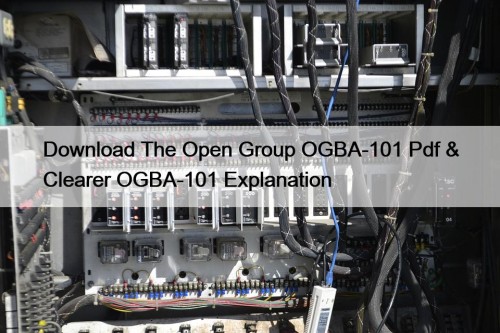Most Popular
 Free PDF Quiz Secure-Software-Design - Reliable WGUSecure Software Design (KEO1) Exam Study Test
Free PDF Quiz Secure-Software-Design - Reliable WGUSecure Software Design (KEO1) Exam Study Test
Real Secure-Software-Design questions in our PDF document can be viewed ...
 Download The Open Group OGBA-101 Pdf & Clearer OGBA-101 Explanation
Download The Open Group OGBA-101 Pdf & Clearer OGBA-101 Explanation
Did you often feel helpless and confused during the preparation ...
 C-THR81-2311 Exam Materials and C-THR81-2311 Test Braindumps - C-THR81-2311 Dumps Torrent - PDFTorrent
C-THR81-2311 Exam Materials and C-THR81-2311 Test Braindumps - C-THR81-2311 Dumps Torrent - PDFTorrent
The software version is one of the different versions that ...



Download The Open Group OGBA-101 Pdf & Clearer OGBA-101 Explanation

Did you often feel helpless and confused during the preparation of the exam? Do you want to find an expert to help but feel bad about the expensive tutoring costs? Don't worry. OGBA-101 learning materials can help you to solve all the problems. OGBA-101 learning material always regards helping students to pass the exam as it is own mission. With OGBA-101 learning materials, you only need to pay half the money to get the help of the most authoritative experts.
The Open Group OGBA-101 Exam Syllabus Topics:
| Topic | Details |
|---|---|
| Topic 1 |
|
| Topic 2 |
|
| Topic 3 |
|
| Topic 4 |
|
| Topic 5 |
|
>> Download The Open Group OGBA-101 Pdf <<
Clearer OGBA-101 Explanation | Learning OGBA-101 Materials
If you buy the OGBA-101 training files from our company, you will have the right to enjoy the perfect service. We have employed a lot of online workers to help all customers solve their problem. If you have any questions about the OGBA-101 learning materials, do not hesitate and ask us in your anytime, we are glad to answer your questions and help you use our OGBA-101 study questions well. We believe our perfect service will make you feel comfortable when you are preparing for your OGBA-101 exam.
The Open Group TOGAF Business Architecture Foundation Exam Sample Questions (Q105-Q110):
NEW QUESTION # 105
Consider the following graphic illustrating a method supporting the TOGAF ADM.
What does the method help identify?
- A. Architecture Solutions
- B. Solution Building Blocks
- C. Alternative Target Architectures
- D. Business Scenarios
Answer: C
Explanation:
The graphic illustrates a method for developing alternative target architectures in Phase E of the TOGAF ADM1. The method involves identifying and evaluating candidate architectures based on criteria such as business value, cost, risk, and feasibility1. The method helps to identify the most suitable architecture solution for the enterprise.
https://pubs.opengroup.org/togaf-standard/adm-techniques/chap10.html
The graphic illustrates a method that supports the TOGAF ADM by identifying and evaluating alternative target architectures. The process begins with a vision, influenced by principles and requirements, leading to the consideration of alternatives. Each alternative is assessed based on different criteria, leading to the selection of the most suitable target architecture. This is consistent with the TOGAF approach of developing a set of potential architectures and then selecting the one that best meets the enterprise's needs.
NEW QUESTION # 106
Which of the following describes how business models are used within the TOGAF standard?
- A. To document the factors impacting the business migration plan.
- B. To help formulate architecture and business principles.
- C. To identify, classify, and mitigate risks to the business.
- D. To tailor the enterprise architecture for the business.
Answer: B
Explanation:
Business models play a significant role in shaping the principles that guide both architecture development and business operations within the TOGAF framework. Here's how:
* Understanding value creation:Business models articulate how an organization creates, delivers, and captures value. This understanding informs the development of architecture principles that support and enable value creation.
* Aligning architecture with business goals:By analyzing the business model, architects can identify the key drivers and priorities of the business. This helps to formulate architecture principles that ensure the architecture aligns with the business goals and strategy.
* Defining desired behaviors:Business models often implicitly or explicitly define desired behaviors and ways of working within an organization. These behaviors can be codified into business principles that guide decision-making and actions across the enterprise.
* Promoting consistency:Using the business model as a foundation for principles ensures consistency between the architecture and the business strategy. This helps to avoid conflicts and ensures that the architecture supports the overall direction of the organization.
NEW QUESTION # 107
Consider the following business capability map. where cells of a model are given different colors to represent desired maturity levels (Green (G) = level achieved, yellow (Y) = one level away, red (R) =two or more levels away, purple (P) = missing capability):
Which of the following best describes what this shows?
- A. Agent Management needs immediate attention. Market Planning. HR Management and Government Relations Management need attention. Customer Management. Training Management and Partner Management need attention but are of lower priority.
- B. Policy Management. Government Relations Management, and HR Management need immediate attention. Partner Management. Account Management, and Training Management have issues but are of lower priority Agent Management Is a new business capability that does not exist
- C. The Strategic capabilities need more attention in two areas. Policy Management, and Government Relations Management. Agent Management is missing as a Core capability Information Management needs attention as a Supporting Capability.
- D. Agent Management needs immediate attention. Market Planning. Government Relations Management, and HR Management have Issues but are of lower priority Partner Management. Customer Management, and Training Management are new business capabilities that do not exist.
Answer: B
Explanation:
The business capability map provided uses color coding to represent the maturity levels of various business capabilities in strategic, core, and supporting functions. The colors indicate the current state or priority for development, with red indicating capabilities that are significantly below desired maturity levels and thus require immediate attention. In this case, Policy Management, Government Relations Management, and HR Management are marked as red, signaling the need for urgent improvement. Yellow indicates capabilities that are closer to the desired state but still need attention, while green shows capabilities that have achieved the desired maturity level. Purple indicates a missing capability that does not currently exist in the enterprise, which is the case for Agent Management.
NEW QUESTION # 108
Consider the following example using the Business Model Canvas:
What are the segments labeled A, D and I?
- A. Customer Relationships, Value Propositions, Market Segments.
- B. Customer Segments, Value Add Services, Profit Channels.
- C. Key Partners, Customer Relationships, Revenue Streams.
- D. Key Resources. Revenue Streams. Cost Structure
Answer: C
Explanation:
The segments labeled A, D and I in the Business Model Canvas are Key Partners, Customer Relationships, and Revenue Streams respectively1. The Business ModelCanvas is a tool that can be used to describe how an organization creates, delivers, and captures value for its stakeholders1. The Business Model Canvas consists of nine segments that cover four main areas: customers (segments B,C,D), offer (segment E), infrastructure (segments A,F,G), and financial viability (segments H,I)1. The segments are defined as follows:
* Key Partners (segment A): The network of suppliers and partners that make the business model work1. Key partners can provide resources, activities, or support that enable the organization to offer its value proposition1.
* Customer Relationships (segment D): The type of relationship that the organization establishes with its customer segments1. Customer relationships can be driven by customer acquisition, retention, or loyalty objectives1. Customer relationships can also influence the customer experience and satisfaction1.
* Revenue Streams (segment I): The sources of income that the organization generates from each customer segment1. Revenue streams can be derived from different pricing mechanisms, such as asset sale, subscription, fee, commission, or advertising1. Revenue streams can also reflect the value that customers are willing to pay for the organization's offer1.
NEW QUESTION # 109
Consider the diagram.
What are the items labelled A, B and C?
- A. A-Architecture Vision, B-Business Architecture. C-lnformation Systems Architecture
- B. A-Enterprise Architecture, B-Architecture Building Blocks, C-Solutions Building Blocks
- C. A-Enterprise Continuum, B-Architecture Continuum. C-Solutions Continuum
- D. A-Enterprise Strategic Architecture, B-Segment Architecture, C-Solutions Architecture
Answer: C
Explanation:
The diagram shows the Enterprise Continuum, which is a view of the Architecture Repository that provides methods for classifying architecture and solution artifacts as they evolve from generic Foundation Architectures to Organization-Specific Architectures4. The Enterprise Continuum comprises two complementary concepts: the Architecture Continuum and the Solutions Continuum. The Architecture Continuum shows the relationships among foundational frameworks, common system architectures, industry architectures, and enterprisearchitectures4. The Solutions Continuum shows the relationships among foundational solutions, common system solutions, industry solutions, and enterprise solutions4.
NEW QUESTION # 110
......
ITPassLeader not only provide the products which have high quality to each candidate, but also provides a comprehensive after-sales service. If you are using our OGBA-101 products, we will let you enjoy one year of free updates. So that you can get the latest exam information in time. We will be use the greatest efficiency to service each candidate.
Clearer OGBA-101 Explanation: https://www.itpassleader.com/TheOpenGroup/OGBA-101-dumps-pass-exam.html
- OGBA-101 Reliable Test Questions 🥀 OGBA-101 Exam Collection 👞 Latest OGBA-101 Test Practice 🤐 Copy URL ➽ www.pass4leader.com 🢪 open and search for ✔ OGBA-101 ️✔️ to download for free 💿Latest OGBA-101 Exam Simulator
- Valuable OGBA-101 Feedback 🦸 Training OGBA-101 For Exam 🐃 OGBA-101 Reliable Test Simulator 🔈 Download ⇛ OGBA-101 ⇚ for free by simply entering ➥ www.pdfvce.com 🡄 website 📐OGBA-101 Reliable Test Simulator
- Training OGBA-101 For Exam 🚄 Exam OGBA-101 Registration 🏀 Latest OGBA-101 Test Practice 🚴 Download ▶ OGBA-101 ◀ for free by simply entering ▶ www.dumpsquestion.com ◀ website 🐪OGBA-101 Reliable Test Simulator
- OGBA-101 Valid Exam Topics 🕦 Valuable OGBA-101 Feedback 📪 Reliable OGBA-101 Exam Book 👝 Open website ▶ www.pdfvce.com ◀ and search for ▛ OGBA-101 ▟ for free download 😇Reliable OGBA-101 Exam Book
- Precise Download OGBA-101 Pdf bring you First-Grade Clearer OGBA-101 Explanation for The Open Group TOGAF Business Architecture Foundation Exam 🍵 Download ▶ OGBA-101 ◀ for free by simply entering ☀ www.torrentvce.com ️☀️ website ⚡Training OGBA-101 For Exam
- Reliable OGBA-101 Exam Book 🎍 OGBA-101 Latest Dumps Free 👏 Training OGBA-101 Material 🏠 Go to website 《 www.pdfvce.com 》 open and search for ➡ OGBA-101 ️⬅️ to download for free 🚄OGBA-101 Valid Dump
- OGBA-101 Latest Dumps Free 💟 Training OGBA-101 Material 🔜 OGBA-101 Exam Consultant ✡ Immediately open ⮆ www.passtestking.com ⮄ and search for ⏩ OGBA-101 ⏪ to obtain a free download 🥝Exam OGBA-101 Registration
- OGBA-101 Certification Exam Dumps 🦼 OGBA-101 Certification Exam Dumps 🚠 Training OGBA-101 For Exam 🗻 Search on ▛ www.pdfvce.com ▟ for ➡ OGBA-101 ️⬅️ to obtain exam materials for free download 🛃OGBA-101 Valid Dump
- Get a Free Demo of www.examdiscuss.com The Open Group Exam Questions and Start Your OGBA-101 Exam Preparation Now 🔻 Open ⇛ www.examdiscuss.com ⇚ enter ☀ OGBA-101 ️☀️ and obtain a free download 🦮Latest OGBA-101 Exam Simulator
- Download OGBA-101 Pdf Exam Pass Certify | The Open Group Clearer OGBA-101 Explanation 📙 Search for 【 OGBA-101 】 and download it for free immediately on ☀ www.pdfvce.com ️☀️ ⛑Reliable OGBA-101 Exam Book
- 2025 High Pass-Rate Download OGBA-101 Pdf | 100% Free Clearer TOGAF Business Architecture Foundation Exam Explanation 📇 Search for ☀ OGBA-101 ️☀️ and download it for free on ➡ www.passcollection.com ️⬅️ website 🕸OGBA-101 Authorized Pdf
- OGBA-101 Exam Questions
- jiyangtt.com 須彌天堂.官網.com yu856.com www.peiyuege.com 羅威天堂.官網.com www.yexihu.cc www.dasnhe.com 5000n-11.duckart.pro www.huajiaoshu.com wzsj.lwtcc.cn
Tags: Download OGBA-101 Pdf, Clearer OGBA-101 Explanation, Learning OGBA-101 Materials, OGBA-101 Valid Exam Forum, OGBA-101 Simulated Test